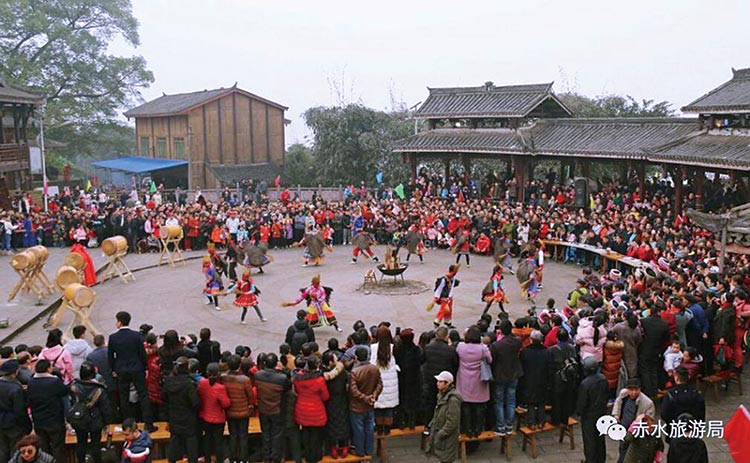Written by: Feng Haobo
Posted on: July 18, 2018 |  | 中文
| 中文
Miao nationality festival in ethnic village of Datong Town, Chishui, Guizhou
Villagers of Dashipan Village of Datong Township, Chishui City, Guizhou Province of China, held a special event full of Miao ethnic flavor, during the Spring Festival of 2018. In their colorful festival costumes, Miao people of the whole village invited visitors from great distances, to join them in their celebratory activities of singing and dancing, playing Lushengs (a kind of reed-pipe wind instrument), drinking rice liquor, and so on.
It is impossible for the visitors to know the days of extreme poverty that the local Miao villagers had to suffer. Years before, they lived in bamboo houses and exchanged hand-woven bamboo baskets at the township markets, for salts and other daily necessities. But ever since they have started to develop local tourism resources, the average family net income has increased to over 10,000 Yuan and the village has become a famous model of getting rich through tourism promotion. Siad Xiaoyan, director of the Tourism Administration said, “At present, there are more than 10,000 people who are engaged in the tourism industry, directly or indirectly, and 20 villages have fulfilled the target of poverty alleviation driven by the tertiary industry in Chishui City.”

Chishui is just a microcosm of China’s poverty reduction in rural areas. China State Council Poverty Alleviation Office issued a list of 28 counties, which have achieved their goals of poverty alleviation. Their accomplishments should be attributed to tourism development. Like the wind of spring, wherever the tourism promotion resolution has been adopted, the flowers have bloomed better.
During the Spring Festival, the Laomudeng Village in Nu Township, Fugong County of Yunnan Province (mainly inhabited by Nu people), was shining under the sun with the sumptuous greenery of grass and trees, and the singing and laughing voices of travelers from various places, who made the atmosphere of the village full of celebration and happiness.
This is in sharp contrast to the poor and backward villages from olden times. In the past couple of years, the local farmers, led by Yu Wulin, have established 16 home-stays for farmhouse tours, with a capacity of hosting 100,000 people a year and an operational income of 4 million Yuan, and a per capita net income of over 6000 Yuan. Poverty-alleviation through tourism was realized by the capable leader who first carried out the trial, and then influenced and guided the rest of the households.
Compared with the model of leading persons to households, the model of villages-driven-by-spots has more obvious effects.
The Yejia Village of Jinyuan County of Ningxia Hui Autonomous Region is only two kilometers away from the Liupanshan National Forest Park. Zhao Wansheng, president of the Farmhouse Tour Association of Yejia Village was fully engaged when asked for an interview. He said "Thanks to the Liupanshan National Park, we have finally been able to cast away poverty." Ten years ago, one third of the village's population was lacking basic necessities, such as food. However, now the net profits of every household have reached an annual sum of 100,000 Yuan, and the best of them had revenues that exceeded 600,000 Yuan.
The Laishui County of Hebei Province has managed to combine the two above mentioned measures together, and villages have been organized to cultivate tourism-related industries, to connect the profits in different sectors together. As a result, the poverty-stricken population has been reduced to 14028 in 2017 from 68725 in 2013.
The Pugu Township of Liupanshui City of Guizhou Province has made active efforts in turning the resources to assets, capitals to shared stock capitals and farmers to share holders. The natural resources, namely the 106800 mu of forests, wet lands, water surfaces and farming lands in 8 villages have been given quantitative calculations and sound commercial operations and the village collectives and farmers have accordingly become the share holders of the profits from the assets. Till now, 3288 people and 885 families have been relieved from poverty.
There is still a lot to be done to alleviate the poverty through tourism development. In 2017, Yunnan Province helped 2000 odd households in the countryside and offered them assistance in tourism development. As a result, 121000 people have been lifted out of poverty. Furthermore, in Guizhou Province, 299500 people have increased their income with local tourism development, and through rural area tourism promotion, 29200 families and 122600 people in Gansu Province have left their backward lives behind.
Presently, the mechanism of poverty-alleviation through tourism has been primarily established in China, with gradually improved policy mechanisms, dynamic industry forms and expanding social influences. The work has made solid achievements throughout China and tourism has become an effective measure and support for poverty alleviation in several areas of the country.
Translated by Wu Jinying
You may also like: